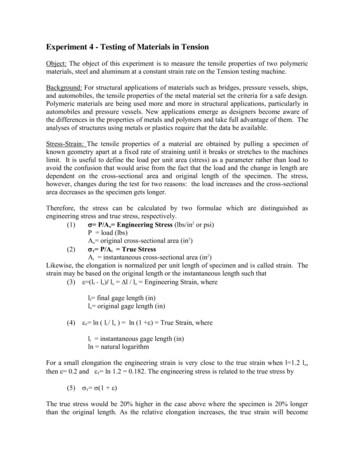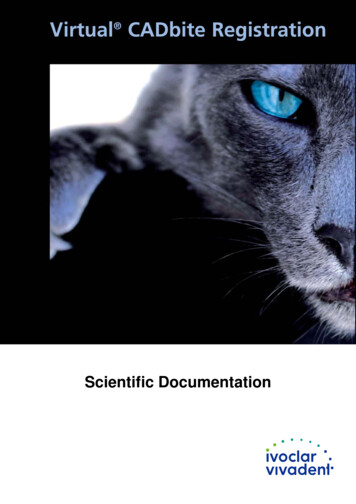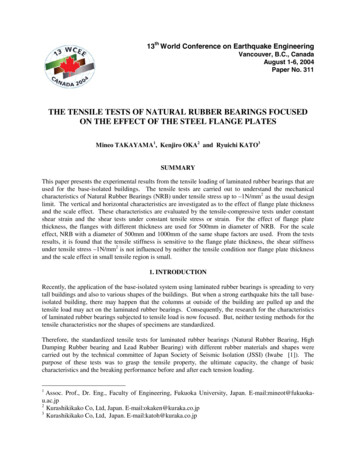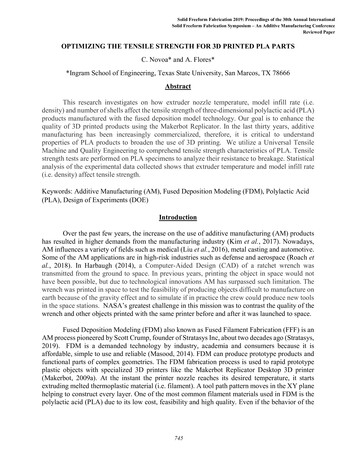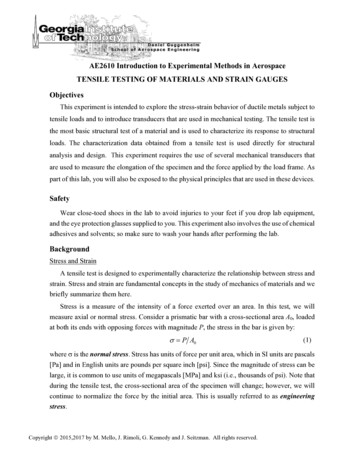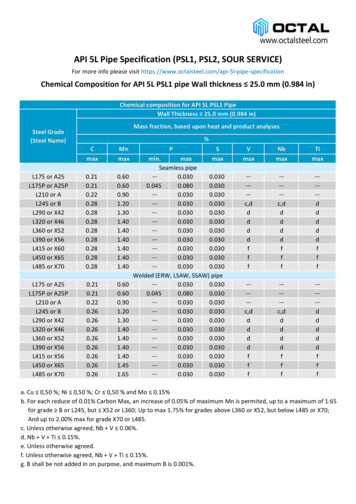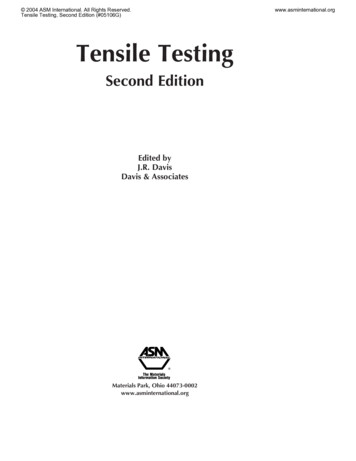
Transcription
2004 ASM International. All Rights Reserved.Tensile Testing, Second Edition (#05106G)Tensile TestingSecond EditionEdited byJ.R. DavisDavis & AssociatesMaterials Park, Ohio onal.org
2004 ASM International. All Rights Reserved.Tensile Testing, Second Edition (#05106G)Copyright 䉷 2004byASM International威All rights reservedNo part of this book may be reproduced, stored in a retrieval system, or transmitted, in any formor by any means, electronic, mechanical, photocopying, recording, or otherwise, without thewritten permission of the copyright owner.First printing, December 2004Great care is taken in the compilation and production of this book, but it should be made clearthat NO WARRANTIES, EXPRESS OR IMPLIED, INCLUDING, WITHOUT LIMITATION,WARRANTIES OF MERCHANTABILITY OR FITNESS FOR A PARTICULAR PURPOSE,ARE GIVEN IN CONNECTION WITH THIS PUBLICATION. Although this information isbelieved to be accurate by ASM, ASM cannot guarantee that favorable results will be obtainedfrom the use of this publication alone. This publication is intended for use by persons havingtechnical skill, at their sole discretion and risk. Since the conditions of product or material useare outside of ASM’s control, ASM assumes no liability or obligation in connection with anyuse of this information. No claim of any kind, whether as to products or information in thispublication, and whether or not based on negligence, shall be greater in amount than the purchaseprice of this product or publication in respect of which damages are claimed. THE REMEDYHEREBY PROVIDED SHALL BE THE EXCLUSIVE AND SOLE REMEDY OF BUYER,AND IN NO EVENT SHALL EITHER PARTY BE LIABLE FOR SPECIAL, INDIRECT ORCONSEQUENTIAL DAMAGES WHETHER OR NOT CAUSED BY OR RESULTING FROMTHE NEGLIGENCE OF SUCH PARTY. As with any material, evaluation of the material underend-use conditions prior to specification is essential. Therefore, specific testing under actualconditions is recommended.Nothing contained in this book shall be construed as a grant of any right of manufacture, sale,use, or reproduction, in connection with any method, process, apparatus, product, composition,or system, whether or not covered by letters patent, copyright, or trademark, and nothing contained in this book shall be construed as a defense against any alleged infringement of letterspatent, copyright, or trademark, or as a defense against liability for such infringement.Comments, criticisms, and suggestions are invited, and should be forwarded to ASM International.Prepared under the direction of the ASM International Technical Book Committee (2004–2005),Yip-Wah Chung, Chair (FASM).ASM International staff who worked on this project include Scott Henry, Senior Manager ofProduct and Service Development; Bonnie Sanders, Manager of Production; Carol Polakowski,Production Supervisor; and Pattie Pace, Production Coordinator.Library of Congress Cataloging-in-Publication DataTensile testing / edited by J.R. Davis.—2nd ed.p. cm.Includes bibliographical references and index.ISBN 0-87170-806-X1. Materials—Testing. 2. Brittleness. 3. Tensiometers. I. Davis, J. R. (Joseph R.)TA418.16.T46 2004620.1 126—dc222004057353ISBN: 0-87170-806-XSAN: 204-7586ASM International威Materials Park, OH 44073-0002www.asminternational.orgPrinted in the United States of Americawww.asminternational.org
2004 ASM International. All Rights Reserved.Tensile Testing, Second Edition (#05106G)www.asminternational.orgContentsPreface . viiSection 1Tensile Testing: Understanding the BasicsChapter 1Introduction to Tensile Testing . 1Tensile Specimens and Testing Machines . 1Stress-Strain Curves . 3True Stress and Strain . 7Other Factors Influencing the Stress-Strain Curve . 7Test Methodology and Data Analysis . 8Chapter 2Mechanical Behavior of Materials under Tensile Loads . 13Engineering Stress-Strain Curve . 13True Stress-True Strain Curve . 18Mathematical Expressions for the Flow Curve . 20Effect of Strain Rate and Temperature . 21Instability in Tension . 22Stress Distribution at the Neck . 23Ductility Measurement in Tensile Testing . 24Sheet Anisotropy . 25Notch Tensile Test . 28Tensile Test Fractures . 28Chapter 3Uniaxial Tensile Testing . 33Definitions and Terminology . 34Stress-Strain Behavior . 36Properties from Test Results . 40General Procedures . 47The Test Piece . 47Test Setup . 54Test Procedures . 56Post-Test Measurements . 58Variability of Tensile Properties . 59Chapter 4Tensile Testing Equipment and Strain Sensors . 65Testing Machines . 66Principles of Operation . 68Load-Measurement Systems . 74Strain-Measurement Systems . 77Gripping Techniques . 83Environmental Chambers . 84iii
2004 ASM International. All Rights Reserved.Tensile Testing, Second Edition (#05106G)www.asminternational.orgForce Verification of Universal Testing Machines . 85Tensile Testing Requirements and Standards . 87Chapter 5Tensile Testing for Design . 91Product Design . 91Design for Strength in Tension . 92Design for Strength, Weight, and Cost . 93Design for Stiffness in Tension . 95Mechanical Testing for Stress at Failure and Elastic Modulus . 97Hardness-Strength Correlation . 99Chapter 6Tensile Testing for Determining Sheet Formability .101Effect of Material Properties on Formability .101Effect of Temperature on Formability .106Types of Formability Tests .107Uniaxial Tensile Testing .107Plane-Strain Tensile Testing .111Section 2Tensile Testing of Engineered Materials and ComponentsChapter 7Tensile Testing of Metals and Alloys .115Elastic Behavior .115Anelasticity .116Damping .118The Proportional Limit .119Yielding and the Onset of Plasticity .119The Yield Point .122Grain-Size Effects on Yielding .123Strain Hardening and the Effect of Cold Work .124Ultimate Strength .126Toughness .127Ductility .129True Stress-Strain Relationships .130Temperature and Strain-Rate Effects .131Special Tests .133Fracture Characterization .134Summary .136Chapter 8Tensile Testing of Plastics .137Fundamental Factors that Affect Data from Tensile Tests .138Stipulations in Standardized Tensile Testing .144Utilization of Data from Tensile Tests .150Summary .152Chapter 9Tensile Testing of Elastomers .155Manufacturing of Elastomers .155Properties of Interest .155Factors Influencing Elastomer Properties .156ASTM Standard D 412 .158Significance and Use of Tensile-Testing Data .159Summary .161Chapter 10Tensile Testing of Ceramics and Ceramic-MatrixComposites .163Rationale for Use of Ceramics .163Intrinsic Limitations of Ceramics .163iv
2004 ASM International. All Rights Reserved.Tensile Testing, Second Edition (#05106G)www.asminternational.orgOverview of Important Considerations for Tensile Testing ofAdvanced Ceramics .164Tensile Testing Techniques .165Summary .179Chapter 11Tensile Testing of Fiber-Reinforced Composites .183Fundamentals of Tensile Testing of Composite Materials .183Tensile Testing of Single Filaments and Tows .185Tensile Testing of Laminates .185Data Reduction .191Application of Tensile Tests to Design .192Chapter 12Tensile Testing of Components .195Testing of Threaded Fasteners and Bolted Joints .195Testing of Adhesive Joints .204Testing of Welded Joints .206Section 3Tensile Testing at Extreme Temperatures or High-StrainRatesChapter 13Hot Tensile Testing .209Equipment and Testing Procedures .210Hot Ductility and Strength Data from the Gleeble Test .215Isothermal Hot Tensile Test Data .220Modeling of the Isothermal Hot Tensile Test .226Cavitation during Hot Tensile Testing .230Chapter 14Tensile Testing at Low Temperatures .239Mechanical Properties at Low Temperatures .239Test Selection Factors: Tensile versus Compression Tests .241Equipment .243Tensile Testing Parameters and Standards .246Temperature Control .248Safety .248Chapter 15High Strain Rate Tensile Testing .251Conventional Load Frames .251Expanding Ring Test .254Flyer Plate and Short Duration Pulse Loading .255The Split-Hopkinson Pressure Bar Technique .257Rotating Wheel Test .260Section 4Reference InformationGlossary of Terms .265Reference Tables .273Room-temperature tensile yield strength comparisons ofmetals and plastics .273Room-temperature tensile modulus of elasticity comparisonsof various materials .275Index .279v
2004 ASM International. All Rights Reserved.Tensile Testing, Second Edition (#05106G)www.asminternational.orgPrefaceIn the preface to the first edition of Tensile Testing, editor Patricia Han wrote “Ourvision for this book was to provide a volume that could serve not only as an introductionfor those who are just starting to perform tensile tests and use tensile data, but also asa source of more detailed information for those who are better acquainted with thesubject. We have written this reference book to appeal to laboratory managers, technicians, students, designers, and materials engineers.” This vision has been preservedin the current edition, with some very important new topics added.As in the first edition, section one opens with an introduction that discusses thefundamentals and language of tensile testing. Subsequent chapters describe test methodology and equipment, the use of tensile testing for design, and the use of tensiletesting for determining the formability of sheet metals.The second section consists of five chapters that deal with tensile testing of the majorclasses of engineering materials—metals, plastics, elastomers, ceramics, and composites. New material on testing of adhesively bonded joints, welded joints, and threadedfasteners has been added.The third section contains chapters that review testing at elevated and low temperatures and special tests carried out at very high strain rates. Although these subjects wereintroduced in the first edition, they have been substantially expanded in this book.In the fourth and final section, a glossary of terms related to tensile testing andproperties has been compiled. Comprehensive tables provide tensile yield strengths ofvarious materials and compare the elastic modulus of engineering materials.In summary, this edition retains much of the flavor of the first edition while introducing readers to a number of additional topics that will extend their knowledge andappreciation of the tensile test.Joseph R. DavisDavis & AssociatesChagrin Falls, Ohiovii
ASM International is the society for materialsengineers and scientists, a worldwide networkdedicated to advancing industry, technology, andapplications of metals and materials.ASM International, Materials Park, Ohio, USAwww.asminternational.orgThis publication is copyright ASM International . All rights reserved.Publication titleProduct codeTensile Testing#05106GTo order products from ASM International:Online Visit www.asminternational.org/bookstoreTelephone 1-800-336-5152 (US) or 1-440-338-5151 (Outside US)Fax 1-440-338-4634MailCustomer Service, ASM International9639 Kinsman Rd, Materials Park, Ohio 44073-0002, USAEmail CustomerService@asminternational.orgAmerican Technical Publishers Ltd.27-29 Knowl Piece, Wilbury Way, Hitchin Hertfordshire SG4 0SX,In Europe United KingdomTelephone: 01462 437933 (account holders), 01462 431525 (credit card)www.ameritech.co.ukNeutrino Inc.In Japan Takahashi Bldg., 44-3 Fuda 1-chome, Chofu-Shi, Tokyo 182 JapanTelephone: 81 (0) 424 84 5550Terms of Use. This publication is being made available in PDF format as a benefit to members andcustomers of ASM International. You may download and print a copy of this publication for yourpersonal use only. Other use and distribution is prohibited without the express written permission ofASM International.No warranties, express or implied, including, without limitation, warranties of merchantability orfitness for a particular purpose, are given in connection with this publication. Although thisinformation is believed to be accurate by ASM, ASM cannot guarantee that favorable results will beobtained from the use of this publication alone. This publication is intended for use by persons havingtechnical skill, at their sole discretion and risk. Since the conditions of product or material use areoutside of ASM's control, ASM assumes no liability or obligation in connection with any use of thisinformation. As with any material, evaluation of the material under end-use conditions prior tospecification is essential. Therefore, specific testing under actual conditions is recommended.Nothing contained in this publication shall be construed as a grant of any right of manufacture, sale,use, or reproduction, in connection with any method, process, apparatus, product, composition, orsystem, whether or not covered by letters patent, copyright, or trademark, and nothing contained in thispublication shall be construed as a defense against any alleged infringement of letters patent,copyright, or trademark, or as a defense against liability for such infringement.
Preface In the preface to the first edition of Tensile Testing, editor Patricia Han wrote "Our vision for this book was to provide a volume that could serve not only as an introduction for those who are just starting to perform tensile tests and use tensile data, but also as
